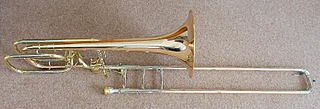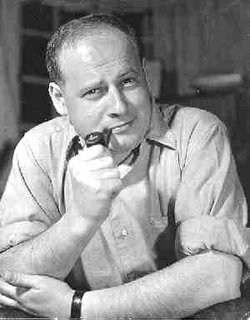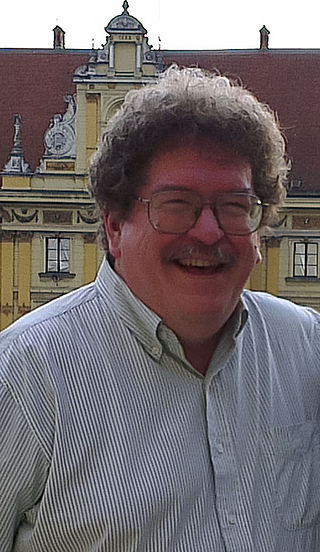
The euphonium is a medium-sized, 3 or 4-valve, often compensating, conical-bore, tenor-voiced brass instrument that derives its name from the Ancient Greek word εὔφωνος euphōnos, meaning "well-sounding" or "sweet-voiced". The euphonium is a valved instrument. Nearly all current models have piston valves, though some models with rotary valves do exist.

An orchestra is a large instrumental ensemble typical of classical music, which combines instruments from different families. There are typically four main sections of instruments:

Royal Liverpool Philharmonic is a music organisation based in Liverpool, England, that manages a professional symphony orchestra, a concert venue, and extensive programmes of learning through music. Its orchestra, the Royal Liverpool Philharmonic Orchestra, is the UK's oldest continuing professional symphony orchestra. In addition to the orchestra, the organisation administers the Royal Liverpool Philharmonic Choir, the Liverpool Philharmonic Youth Company and other choirs and ensembles. It is involved in educational and community projects in Liverpool and its surrounding region. It is based in the Liverpool Philharmonic Hall, an Art Deco concert hall built in the late 1930s.
Simon Proctor is a British composer and pianist, known for his works for unusual instruments.
Fritz Spiegl was an Austrian-born English musician, journalist, broadcaster, humorist and collector who lived in Britain from 1939. His works include compiling the Radio 4 UK Theme in 1978.

The serpent is a low-pitched early wind instrument in the brass family developed in the Renaissance era. It has a trombone-like mouthpiece, with tone holes and fingering like a woodwind instrument. It is named for its long, conical bore bent into a snakelike shape, and unlike most brass instruments is made from wood with an outer covering of leather. A distant ancestor of the tuba, the serpent is related to the cornett and was used for bass parts from the 17th to the early 19th centuries.

Gordon Percival Septimus Jacob CBE was an English composer and teacher. He was a professor at the Royal College of Music in London from 1924 until his retirement in 1966, and published four books and many articles about music. As a composer he was prolific: the list of his works totals more than 700, mostly compositions of his own, but a substantial minority of orchestrations and arrangements of other composers' works. Those whose music he orchestrated range from William Byrd to Edward Elgar to Noël Coward.

The bass trombone is the bass instrument in the trombone family of brass instruments. Modern instruments are pitched in the same B♭ as the tenor trombone but with a larger bore, bell and mouthpiece to facilitate low register playing, and usually two valves to fill in the missing range immediately above the pedal tones.

Gerard Hoffnung was an artist and musician, best known for his humorous works.
Sergei Rachmaninoff composed his Piano Concerto No. 1 in F♯ minor, Op. 1, in 1891, at age 17-18. He dedicated the work to Alexander Siloti. He revised the work thoroughly in 1917.

Eric Ewazen is an American composer and teacher.

Johannes Abraham "Johan" de Meij is a Dutch conductor, trombonist, and composer, best known for his Symphony No. 1 for wind ensemble, nicknamed The Lord of the Rings symphony.

The double bell euphonium is a duplex instrument based on the euphonium. The larger bell produces the mellow tone of a standard euphonium; the second smaller bell has a brighter tone, similar to a baritone horn or valve trombone. The instrument is sometimes dismissed as a novelty, but has had a small number of enthusiastic adherents, although few professional musicians use it as their sole or primary instrument. The smaller bell can give more appropriate tone in the higher range of the instrument. The two bells can also be used for special effects, such as echoes, and using the distinctly different tone of the two bells for a single musician to give the effect of call and response.
Margaret Brouwer is an American composer and composition teacher. She founded the Blue Streak Ensemble chamber music group.

The euphonium repertoire consists of solo literature and parts in band or, less commonly, orchestral music written for the euphonium. Since its invention in 1843, the euphonium has always had an important role in ensembles, but solo literature was slow to appear, consisting of only a handful of lighter solos until the 1960s. Since then, however, the breadth and depth of the solo euphonium repertoire has increased dramatically.

Steven Mead is an English virtuoso euphonium soloist and teacher who has played an important role in achieving worldwide recognition of the instrument. He has played solo concerti with many symphony orchestras, including: the Stuttgart Philharmonic Orchestra, the Trondheim Symphony Orchestra, Lahti Symphony Orchestra and Helsinki Philharmonic, Capella Cracoviensis, the Minneapolis Pops Orchestra and the Japan Chamber Orchestra. He has premiered works by Martin Ellerby, Torstein Aagaard-Nilsen, Vladimir Cosma, Goff Richards, John Reeman, Rolf Rudin and Philip Sparke, amongst others. Goff Richards' Pilatus, Aagaard-Nilsen's Concerto for Euphonium and Orchestra, Reeman's Sonata for Euphonium and Ellerby's Euphonium Concerto were all written expressly for Mead.

Jennifer Irène Paull is a musician, writer, author, and publisher.
The culture of Liverpool incorporates a wide range of activities within the city of Liverpool, England. The city is an important centre for culture not just in the northwest of England, but also the United Kingdom more broadly. Its contributions to culture internationally were recognised in 2008, when it was named the European Capital of Culture.

The soprano trombone is the soprano instrument in the trombone family of brass instruments, pitched in B♭ an octave above the tenor trombone. As the bore, bell and mouthpiece are similar to the B♭ trumpet, it tends to be played by trumpet players rather than trombonists. Compared to tenor, bass, or even uncommon alto, the soprano is a rare trombone. Seldom used in classical music since its first known appearance in 1677, it survived principally in the trombone ensembles of Moravian Church music. During the 20th century some soprano trombones—dubbed slide cornets—were made as novelties or for use by jazz trumpet players including Louis Armstrong and Dizzy Gillespie. A small number of contemporary proponents of the instrument include jazz artists Wycliffe Gordon and Christian Scott, and classical trumpeter Torbjörn Hultmark, who advocates for its use as an instrument for young children to learn the trombone.














